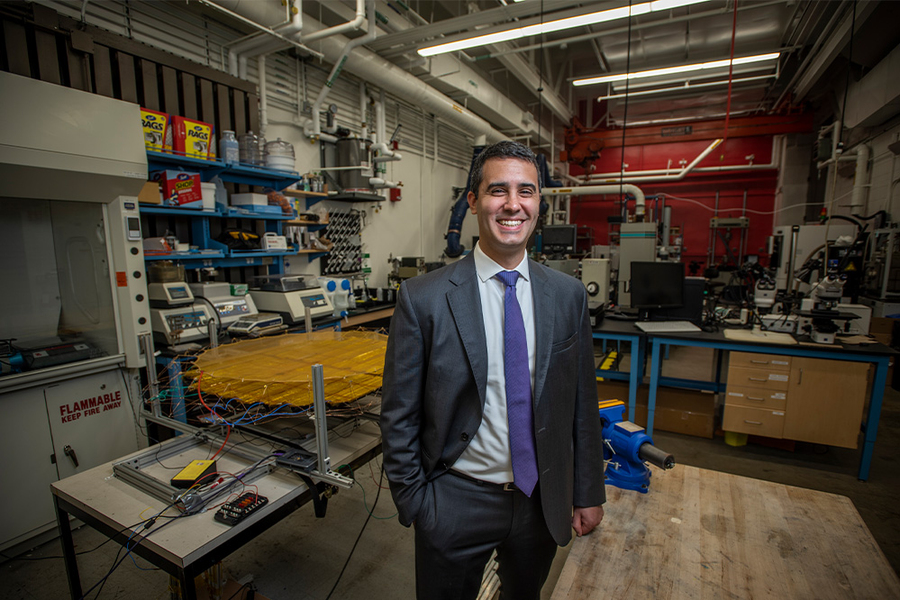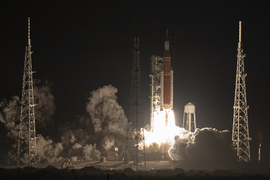The success of the SpaceX Falcon 9 reusable launch vehicle has been one of the most remarkable technological achievements of the last decade. Powered by SpaceX’s Merlin engine, the Falcon 9 booster can be reused over 10 times, with minimal maintenance between flights.
Now there is a new generation of reusable rocket engines and vehicles that promise much larger payloads and greater reuse. Unlike Falcon 9, the 390-foot-tall SpaceX Starship, powered by its new Raptor engines, can land both the booster and the second stage for reuse, thereby further reducing launch costs. Blue Origin has its own next-generation BE-4 engine that will power its 320-foot New Glenn launch vehicle.
“The new class of reusable launch vehicles is likely to transform the space industry by lowering launch costs and improving space accessibility,” says Zack Cordero, the Esther and Harold E. Edgerton Career Development Assistant Professor of Aeronautics and Astronautics at MIT. “This will enable applications such as mega constellations for space-based internet and space-based sensing for things like persistent, real-time CO2 emissions monitoring.”
Yet, launch failures such as the April 2023 explosion of SpaceX’s Starship prototype suggest that the new designs still have significant reliability issues. In the Starship explosion, about six of the 33 Raptor engines on the boost stage appear to have malfunctioned. In June, Blue Origin’s BE-4 engine exploded during acceptance testing, suggesting the engine suffers from similar challenges.
“People assume that Starship is going to succeed, but that isn’t necessarily true,” says Cordero. “There is a real, underappreciated risk that these new heavy lift launch vehicles will continue to fail unless there are fundamental advances in materials technology.”
The Cordero Lab, based in the MIT Aerospace Materials and Structures Laboratory, has accepted this challenge with a variety of projects that aim to solve the reliability problem at the materials level. Working with partners including NASA, which plans to use Starship for its crewed Artemis missions to the moon, Cordero is leveraging expertise in additive manufacturing (AM), processing science, materials engineering, and structural design. The goal is to reduce the maintenance costs and extend the lifespan for reusable rockets while decreasing the chance of catastrophic failure.
Reusable rocket research is just one of several Cordero Lab projects to address emerging aerospace applications. Cordero is also developing technologies for in-space manufacturing of larger space structures such as solar cells, solar sails, and reflectors, enabled by the greater payloads of heavy-lift reusable rockets. Cordero’s novel manufacturing technique uses plastic deformation to fold metallic feedstock into net-shaped reticulated structures. These structures can then precisely contour a reflector surface using embedded electrostatic actuators.
Bigger reusable rockets = bigger reliability challenges
Unlike traditional, expendable rockets, reusable launch vehicles must integrate components and design elements that allow the vehicles to automatically maneuver for a soft landing. They also require greater thermal protection to withstand extreme aerothermal heating during reentry.
“Propulsion devices need to be designed differently for reusable rockets,” says Cordero. “With reusable liquid propellant rocket engines, you must ensure safe operation over multiple flight cycles and ease off on performance to reduce stress.”
Larger, more powerful reusable rockets make these design additions even more challenging. “SpaceX’s Raptor and Blue Origin’s BE4 engines operate on different power cycles compared to the Merlin engine,” says Cordero. “The new staged combustion power cycles are more amenable to reusability because they lower turbine inlet temperatures to extend the life of turbine hardware. Yet, the new power cycles pose a greater risk of catastrophic failure. Oxygen compatibility and metal fires represent critical challenges.”
Cordero is attempting to strengthen the components that limit the life of a reusable rocket engine, starting with the turbopump that pressurizes the liquid propellant. Other vulnerable components include the thrust chamber in which propellants are burned to create a hot gas, as well as the nozzle through which the gas is exhausted.
Extended wear on turbopumps, chambers, and nozzles does not always end in a catastrophic explosion. Yet, they add to the maintenance and repair costs that are factored into overall launch payload costs.
“There is a wide spectrum of failure behaviors,” says Cordero. “Thrust chambers can start to crack but continue to function. Yet, turbopumps can have more serious issues. There could be a blisk [a type of rotor disc] failure or in the case of oxygen-rich turbopumps, a rub between the rotor and casing. The new engines are also vulnerable to particle impact ignition in which FOD [foreign objects and debris] are accelerated into a surface, igniting the hardware. In a turbopump, these ignition modes can lead to a metal fire and a catastrophic, single-point failure mode that results in the vehicle exploding.”
The growing role of AM in reusable rockets
Additive manufacturing is now widely used in the space industry, including printing parts for launch vehicles with laser power bed fusion printers. “Space is probably the heaviest user of metal AM and is basically dictating technological developments,” says Cordero.
AM is frequently used to print metal propulsion devices such as the small pumps used in gas generator engines. However, it is only selectively used in larger boost stage engines and their turbopumps.
“There is a debate over whether metal 3D printing of large structures is economical,” says Cordero. Yet, improved quality control and qualification protocols have enabled greater use in large, mission critical-flight devices. The next step is developing novel materials that improve reliability.
“We are developing material advances that should enable greater use of AM for larger turbopumps,” says Cordero. “Our technology enables novel designs with improved thermal efficiency or resilience against high temperatures or rapid thermal transients.”
One critical challenge for full-flow staged combustion (Raptor) and oxygen-rich stage combustion (BE-4) engines is the problem of oxidizer compatibility. “In the turbine and downstream hardware, you often see high-temperature, high-pressure oxygen gas, which can drive metal fires and rapid energetic failure modes,” says Cordero.
One solution is to design a pump with larger clearances in the rotating hardware. Yet because this approach degrades performance, Cordero has chosen another path: using metal AM to create more intrinsically oxygen-compatible materials. “Building oxygen-rich turbopumps with metal AM makes it easier to integrate exotic materials that are more compatible with high-pressure, high-temperature oxygen environments,” says Cordero.
Cordero Lab is pursuing this approach with two projects. The first is developing oxygen-compatible ceramic coatings that protect against particle impact ignition. The second is creating ignition-resistant AM materials that can be printed into complex net shapes to avoid friction ignition.
Toughening up coatings with metallic ductile phases
In the coating project, stationary and rotating components in oxygen-rich turbopumps are coated with an inner ceramic coating that prevents heat transfer to the substrate and protects the metal from high pressure oxygen. “The advantage of coatings is that you can apply them to almost any kind of hardware whether printed, cast, or forged,” says Cordero.
The material improves on current ceramic coatings used in conventional gas turbine designs. “Conventional aero coatings tend to delaminate and break apart under the rapid thermal transients that are typical in rockets,” says Cordero. “In an aero engine, the engine starts up in over a minute, then idles a few minutes before taking off. By contrast, a rocket engine goes to full throttle in a split second. The rapid change from very low to very high temperatures generates incredible stresses that cause conventional coatings to pop off.”
To solve this problem Cordero is using toughened ceramic coatings with embedded metallic ductile phases that suppress delamination via crack bridging. “If cracks develop in the ceramic coating, they are bridged and held in place by metallic inclusions that help it to withstand the thermal transients,” says Cordero.
The Cordero Lab has successfully tested the coatings with typical thermal transients seen in rockets. “Now we are exploring how to apply them to real-world flight hardware and optimize their composition and design for higher turbine inlet temperatures,” says Cordero.
The researchers are collaborating with NASA to investigate the particle impact ignition resistance of the coatings using different thicknesses, particle sizes, and operating conditions. “Our research into fundamental principles of ductile phase toughened environmental barrier coatings should allow us to develop new coatings with chemistries and properties specifically tuned to different applications,” says Cordero. One potential application is to “cover acreage aero-surfaces on hypersonic vehicles.”
Printing friction-resistant alloys
Cordero Lab’s research into ignition-resistant alloys is a collaboration with Aerospace Corp., a nonprofit federally funded R&D center. The lab is investigating the mechanisms that drive frictional ignition, another ignition mode that can lead to metal fires.
Frictional ignition, which “is like striking a match when the match is traveling at 300 meters per second,” is often caused by a rub between the rotor and casing, says Cordero. To reduce the risk, Cordero is designing new printable superalloy materials that incorporate oxide nanoparticles for dispersion-strengthening. Dubbed TGT100, the material “can be printed into complex net shapes and offers best-in-class frictional ignition resistance.”
The burn-resistant material will first be used to print casing and stationary hardware. Cordero has launched a startup called Top Grain Technologies that will commercialize the material, as well as the ceramic coatings.
Cordero has recently begun to investigate how turbopumps could be redesigned using his new materials to achieve extremely long lifespans. “Our goal is to build a turbopump that can endure hundreds of hot cycles before replacing or repairing components,” says Cordero.
Solving the reliability issues of reusable rockets will require expertise in cross-disciplinary subjects that are not typically paired. Toward this end, Cordero recently worked with the MIT Department of Aeronautics and Astronautics and the Industrial Liaison Program to launch a new one-week crash course in AM for aerospace engineers.
Cordero has also organized a yearly workshop with collaborators from Aerospace Corp. and Lehigh University that explores materials challenges in reusable rocket engines. “We are bringing together experts from academia, industry, and government to discuss the key technical challenges,” says Cordero.
Beyond education, more collaboration is needed between academics and companies like SpaceX and Blue Origin, says Cordero. “The academics have more time to explore these more fundamental challenges,” he says. “The vision is to bring reliability and reusability of reusable rocket engines up to the standards of aero engines, which would transform the industry.”









